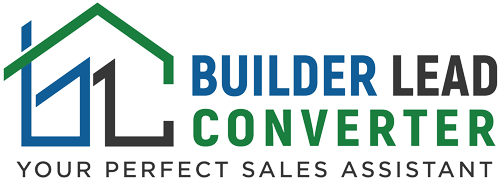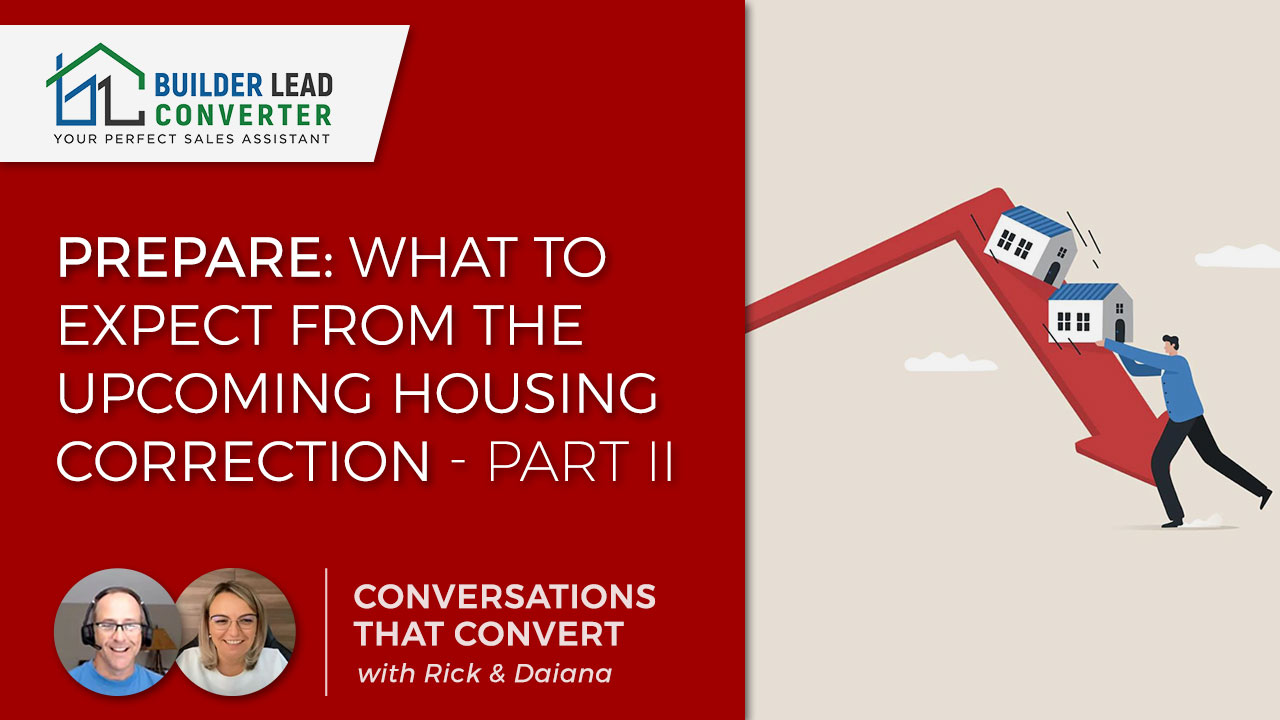The housing market is finally starting to cool off! Some remodelers, builders, and home improvement companies may welcome a housing correction as an opportunity to grow market share, most should brace for fewer buyers ahead.
In our previous episode, we discussed 3 of 6 key moves home builders & remodelers can make to prepare for the impact of a recession on their local housing market. In this week’s episode, we’ll take in the last three (4 to 6) “Prepare Moves”…
- The mistake to avoid when pricing your homes
- Where to start looking for more lead opportunities
- Places to focus your marketing budget
Even if you don’t think your business will be affected by the downturn, it’s important to understand what’s happening in the market and take precautions to protect your company, so watch/Listen or read this episode below. Let’s dive in!
”
Builder Lead Lead Converter captures & converts leads for home builders & remodelers so they can grow sales revenue and margins. Find out how https://www.builderleadconverter.com/
Transcript:
Today on Conversations that Convert. We’re gonna talk about how to prepare for the upcoming housing correction. Let’s get started.
Welcome to Conversations that Convert every week, we’ll spend about 10 to 15 minutes tackling relevant lead generation marketing and sales topics for remodelers, home improvement companies, and home builders. Conversations that Convert is brought to you by builder lead converter, your perfect sales assistant.
And now here’s Rick and Daiana.
Rick: Good morning and good afternoon if you’re on the east coast. Welcome to conversations that convert. Daiana, how are you?
Daiana: I’m doing great. Thank you. And how about you?
Rick: Very fine. Thank you. Wonderful to see you again. And so excited about today’s show. We’ve got some, some great stuff. What are we talking about today?
Daiana: What do I expect from the upcoming housing correction? And that is part two.
Rick: That’s right, part two. Last week we did part one and we’re gonna go through it again, part two is here today, as far as helping you prepare for a housing correction in your local market. So this is all part of our, builder’s guide to recession proof, your business series, and we’re gonna look at three more key moves that home builders and remodelers can make to prepare for the impact of a recession on your local housing market. Now, Daiana, who is your favorite electric vehicle? Car maker?
Daiana: Well, mine is, well it’s I think it’s, it is not like yours. It’s a BMW.
Rick: Oh, no, we gotta focus on, we’re gonna talk about Elon Musk. Yes, our Tesla manufacturer. Of course, you drive a BMW. People don’t know what an electric car is, no less. But we’re gonna, this is all based on Elon Musk, excuse me, predict, prepare, and persevere or PPP strategy. So we’ve been spending episodes on each one of these. How does a home builder predict or remodeler predict a housing recession? How do you prepare for it? And then we’re gonna talk about next week, beginning, next week to persevere through it. So we call it the PPP strategy. So, Daiana, what do you think? Should we review the three moves that we talked about last week?
Daiana: Yes, please do that. Start with the first three, and then we’ll continue with the next three.
Rick: So we started with last week, looking at where to start to reduce your credit lines, pay off loans, and conserve cash. And then we discussed how to get in front of the market versus chasing it down. This is probably a really critical mistake that a lot of builders make is that when it’s time to reduce price, they do it too slowly and too late. So what that causes is, you know, you’re chasing the market down and then that just causes you to pay a lot more interest, and, or opportunity costs on the money you’ve got tied up in spec homes that you’re trying to move or, or land too, that you, that you’re trying to move. And then the third one was, we talked about reducing overhead and really trying to categorize your employees and move on from those employees that maybe fall in the bottom tier of your, of, of your grouping. So what do you say, Daiana? Should we talk about four, five, and six?
Daiana: Yes. I’m curious. So what’s number four?
Rick: All right. Well, number four, we’re gonna talk about adopting market-based pricing versus cost plus for spec homes. So market-based pricing versus cost, plus for spec homes. You’re a remodeler I don’t build spec homes yet I get it. But in, if you’re a home builder, you may or not build spec homes. But spec homes are still no matter what the market is doing. Spec homes are still a viable way to burn through land inventory and, or, you know, fill in production gaps and just meet the market. There are certain markets where people don’t wanna wait to build. And if you’re not in the spec home market, you’re never gonna capture that market. Even if the market’s going down, we, we still wanna look at, at spec homes. So number one, what is market-based pricing versus cost plus? Well, most builders when they build a spec home, simply look at the cost sheet, they put their markup on there, so they get their anticipated net margins and, or, or gross margins. And then they, and then they build the home and that’s how they price it. So market-based pricing is where you actually look at the value of that home before you build it, or when it’s completed, you evaluate, and where’s the value of this home based on recent sales in the marketplace. So we call it a CMA or competitive market analysis. That’s what realtors do when they price homes and you need to do the same thing when you’re building spec homes. So a, a couple of things to, to keep in mind when it, when it comes to spec homes. First of all, if you’re gonna build a spec home, you need to upgrade your location. And so what I mean by that, Daiana is that if a lot of times you build spec homes, maybe in locations that have lower demand. And so you’re trying to burn through some of those lots. So we’re gonna grade our locations, A, B, C, D, E, or maybe A through D you wanna build spec homes and A locations now? Then you wanna look at the individual lot. You’re building on most of the time, the spec home is built on a lot that is less desirable. We wanna build it on a lot that is more desirable. So when that spec home was completed, it was in a high-demand area and it’s in a high-demand lot. even if that pushes the price of that spec home, As long as you’re doing your research and you’re filling a gap in the marketplace. That’s okay. Again, cuz it’s gonna have more appeal to it, a higher emotional appeal when it’s completed. Any thoughts on that, Daiana?
Daiana: Sure. That’s very interesting. So it’s worth the risk if it’s a good location and the lot it’s, It’s, it’s on demand. So…
Rick: Yeah, exactly. One of the things that a lot of builders get mixed up in the market drops, they think they need to drop prices across the board and everything. Right. But sometimes you get a lot of people that are all dropping down to a certain price tier. And what it does is that it raises the inventory levels of that price tier, which makes it more advantageous for the buyer. Cause there are more choices. Yeah. So that slows down absorption. That causes interest costs and higher interest costs, and it’s just gonna be more competitive for you. So you look for gaps. Each market has these gaps. So you find out where is that hole in the market, where there’s, there’s still demand, but there’s not a whole lot of inventory and you can adjust your offerings in there. So sometimes you go up. You can go up a price category. Now that usually means you have to do some sort of an improvement on the home. And a lot of times what I like to test is that improvement would be something on paper. So here’s an example. If I live in a certain warm market climate, pools are very desirable. So maybe I have a spec home that doesn’t have a pool built yet. So what I can say is that I’m gonna add $50,000 to the cost of this home. And I’m gonna include a pool in it. So now on paper, it looks like there’s a pool on this home and I go up a price category and that becomes something that’s, you know, more desirable to a specific type of home buyer. If it doesn’t work out where I still don’t sell the home, I can always remove the pool, cuz it’s just on paper. I can drop the price down and go into a different category without a pool.
Daiana: I like that.
Rick: Yeah. And like, you’re in a cold market climate, like I’m not, you know, you’re in, you’re in Romania, you have older homes there, but if you’re in a cold market climate, we, we put in basements, cuz we have to protect the basement or the footings from cold temperatures. So in a cold market climate, I could do the same thing with a basement. I can, I, can I have a foundation, it’s unfinished. I could say, you know what, I’m gonna raise the price by 30, 40, $50,000. And I’m gonna say it includes a bedroom, a bathroom, another living area, and so many square feet. And so the price goes up, but at the same time, the average cost per square foot goes down. Because when I finish a basement, it’s much less expensive than if I were just building the home from scratch. So I’m doing that with one client right now, you know, where we’re, we’ve got some back homes we’re playing with the market. So we’re going up with some. We’re testing it there, we’re going down with others. And if you have more than one spec home that you’re trying to sell by creating a bigger spread between the two, that helps differentiate them and it will help sell one. So we, this particular client, have two homes. In the same area that is essentially competing with one another. So instead of trying to price them identical, which is a mistake too, because if a buyer doesn’t see any difference that causes them to contemplate versus make a decision. So what you wanna do is you wanna provide a clear difference. So we took one home up by adding a basement on paper. It’s not really there, but we say, we were gonna include this. We went up and then we took one that’s down. So now we’re $40,000 apart for a very similar. So that allows us to test both, both markets and hopefully we’ll get one sold. And then one that sells that’ll give us direction of where we should go with the one that still is for sale.
Daiana: Nice strategy. And now let’s move to our fifth move.
Rick: Yeah. Number five. So we wanna plug your organic lead opportunity leaks. And when I say organic lead opportunity leaks in the last two years, most builders and remodelers really haven’t had to do a whole lot as it relates to lead generation, there was so much demand in the marketplace. The leads came. You, you didn’t really have to work at it. What that led to of course are opportunity leaks. And I say opportunity leaks because you have opportunities and all of your different platforms. So if you have signup, you have the potential to get a sign call, you have a website up, you have the potential to get a website lead. You have a social media platform. You have the potential to get a lead from social media, as well as ads and so on, and so forth. So organic opportunity leaks are any way that a lead would find you organically. So in other words, it would be a non-paid strategy. The biggest opportunity leaks that I find on your website. And one of the things you need to look at is, how many years has your website been around. In other words, when was the last time it was rebuilt, revamped? What I say is the rule of thumb is two years. Every two years, you should be updating your website. So the first thing I would do is update your website, and focus on improving the look and the user experience. So technology continues to evolve when it comes to websites. So you have to just continue to update it, to keep up with that technology, continue to improve that user experience because the key is, if you’re gonna get a lead on your website, you gotta keep the person on your website. A bounce is when they come onto one page and leave from the same page, we wanna avoid bounces. We wanna keep them on the site. So go into pages two, three, and four, etcetera. The other thing that I wanna do from my opportunity leak standpoint is that I wanna improve my follow-up and conversion funnels. So most builders are still relying on human or organic follow-up. So, the problem though is that that cannot be done on a timely basis. So the question for you, Daiana, what is the amount of time that a builder or a modeler should strive to reply to a new lead? So in other words, if a new lead comes in, how much time should pass before the builder or remodeler replies?
Daiana: I can say immediately, that’s the ideal answer, but let’s say no more than 24, 48 hours.
Rick: Yeah. And that’s what most builders think is 24 to 48 hours. In truth, you wanna do it in one. One minute.
Daiana: In one minute.
Rick: Yep. So the problem with the immediate response is then, then the lead knows it’s automated.
Daiana: Right.
Rick: If you wait one minute, then it looks like it’s organic. So you wanna make your responses organic as well? So you want, yeah, wait about one minute and get back to them. And ideally, you get back to them with more than one platform. So you just say, you need to update that and that’s all about setting up a conversion funnel. Now that’s kind of a weird term conversion. But conversion funnels are simply what is the plan for taking that lead to an actual conversation? So when somebody comes into your website and they say, I’m, here’s my information. I’m interested in this. You have to go through a series of steps in order to get them on the phone, qualify them, and then confirm if they’re revivable prospects. So you need to set up a funnel for that. The worst thing you can do is not have a funnel and have it completely rely on, say a human, a one, one person doing it. The problem with relying on a human is that humans. We are, we make a lot of mistakes. We get busy, we forget, we, we wanna remove that human element. So we wanna automate that conversion funnel and really then measure our effectiveness, which each way that we follow up with that, that lead. And then finally we want to reach out to past clients and organic lead opportunity leaks. There’s a huge opportunity for past clients for getting reviews, for getting referrals, and offer additional projects. If you’re in remodeling or even home billing is, you know, say, Hey, look, if you’re ready to build a home again, if you are ready to start another remodeling project, you have an opportunity for them. So you have a built-in database of people that already like you, trust you, and know you, they see the value of what you’re doing. Why not target them, to get more business?
Daiana: And then move number six.
Rick: Yeah. So move number six is counterintuitive. So most of the time when we see the market cooling off and we see less business coming in the door, we tend to pull back on our marketing budget. We spend less, we actually need to spend more on our marketing budget. And the reason is, is that it’s just gonna be harder to get business. So when business is good, we can spend essentially, almost nothing because people are coming to us when the market gets tough, and there’s a lot more competition for fewer amount of buyers. And so we need to have more exposure to those buyers on different platforms in order to get a limited amount of opportunities. And so we have to spend more now here’s where most of the time builders think, they should go first, first I think, oh, I should start running ads. So they just start running ads and then they just throw money at it. And it’s very expensive and there’s very little return on investment. And a lot of times it’s not tracked properly. So where you wanna increase your marketing budget first is for organic SEO, which is search engine optimization. When somebody finds you organically, the conversion percentage goes up dramatically. And organically means that they do a Google search for you. They find you on your social media platform. They see your sign. It’s, they’re looking for something where they’re, they’re searching out, they find you organically, paid ads are what’s called interruption marketing versus permission-based marketing. So interruption marketing, it’s always a lower conversion because you are interrupting them. So really. The desire of that lead is not as high as that of somebody who’s searching you out. So organic SEO first, and again, budget-wise, you probably need to prepare, you know, somewhere between I’m guessing 800 to probably 1,500, $1,800. It depends on how competitive your market is and what you’re trying to rank for as far as, services and, and locations. For example, let’s say you’re in a major market like Houston, trying to rank for custom homes or kitchen remodeling in Houston is gonna be very expensive. It’s gonna be hard to do. But if you were to go to some of the smaller communities around that Houston market, much easier to rank for, and there are still people that are living in those communities that need to remodel theirs. So that’s what you, I would suggest then once you get your organic SEO done, then you would move over to paid ads. So if we go back to plug in your organic opportunity leaks again, start with your website, you’re any organic traffic, you’re already getting your social media presence, focus on your current past clients for getting referrals, second projects, and so on, so forth. And then what you wanna do is you wanna boost your organic SEO and paid ads. And don’t forget if your website is more than two years old, it’s time to rebuild it. Any final thoughts, Daiana?
Daiana: Yeah, it struck me that only two years, now the technology is, is available and then you have to, to review it or, or it’s a continuous, continuous learning and continuous work to update and be up to date with everything that’s happening online.
Rick: No, I think websites are a good metaphor or that is to look at the design. So home design changes constantly. So what was really popular two years ago, from a motif standpoint, even products, changes all the time. Car manufacturers do the same thing. They have to come up with new models every year to create a reason for somebody to actually buy a new car. Cuz otherwise if the cars are saying yearning you’re out, well, why would you buy a new car?
Daiana: Yeah.
Rick: So a website is just like that, is that not only from a functionality standpoint? But also from a look and feel websites are evolving as well, you know, look and feel the change. And, what was once popular and trendy is now outdated and old. And so, subconsciously what you’re doing is when that lead lands on the website, you’re telling them, you know what, we’re really not up to date. We’re gonna really not speed to some of our competitors. And it’s really a ding against you, right from the start. So yes, your website needs to be updated. You should have a fresh social media presence, which means you’re posting regularly. Ideally, you have a blog that is updated regularly. Information on your website’s updated regularly, but most importantly, it looks and feels relevant because it looks like a modern website that many other types of businesses are using.
Daiana: Thanks for sharing. That’s very valuable.
Rick: Absolutely. And if you’d like to schedule your strategy call to find out how we can help you prepare and prosper in a recessionary housing market, go ahead and just click the link right below here, and we’d be happy to help you do that. So for my brothers and sisters in Christ made the grace of the Lord Jesus Christ, the love of God, and the fellowship of the holy spirit be with you all, always. We will see you next time on conversations that convert. Bye-bye.
Daiana: Bye.






Recent Comments